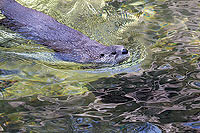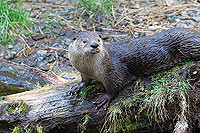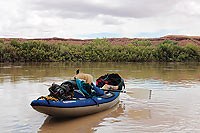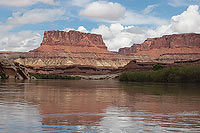 Thirty years ago, seeing a river otter in the Colorado River or one of its tributaries was a rare sighting. Though never really considered abundant in the river system, populations of these aquatic animals were reduced because of unregulated trapping, habitat loss, and excessive pollution.
Thirty years ago, seeing a river otter in the Colorado River or one of its tributaries was a rare sighting. Though never really considered abundant in the river system, populations of these aquatic animals were reduced because of unregulated trapping, habitat loss, and excessive pollution.
In the late 1980s, river otters were reintroduced into the Escalante, Green, Provo, and other waterways as a management tool to return this creature to its former haunts. Since then, the otters have expanded into these rivers and some lakes and other tributaries around the state.
Otters prey on fish, but also eat amphibians, small mammals, young waterfowl, and crustaceans such as crayfish. Able to catch prey with their sharp teeth, otters hunt mainly in the water but their short, powerful legs enable them to run down prey on land. Their hind feet are webbed which act like flippers as the animals propel themselves underwater. Narrow bodied, the animals are underwater acrobats, able to quickly move about or change directions. And their long tails act like a rudder, helping the otter to steer in the water or for balance on land.
 Related to weasels, minks, and martens, otters have scent glands beneath their tails that enable them to mark their territories with powerful, musky odors. Unlike their distant relatives the skunks, otters don’t use these glands for protection or as a warning to predators. Rather, the animals will choose to either escape into a body of water or use their sharp teeth to bite an intruder. Interestingly, otters have fairly large noses for an aquatic animal but like a dog, otters use their large noses to gather information from these scent markings.
Related to weasels, minks, and martens, otters have scent glands beneath their tails that enable them to mark their territories with powerful, musky odors. Unlike their distant relatives the skunks, otters don’t use these glands for protection or as a warning to predators. Rather, the animals will choose to either escape into a body of water or use their sharp teeth to bite an intruder. Interestingly, otters have fairly large noses for an aquatic animal but like a dog, otters use their large noses to gather information from these scent markings.
Living in family groups of females and their young (cubs) or a group of unrelated males, these social animals may be seen hunting together or even “playing” on land where they slide down muddy banks or glide across the ice. The otter’s slides and their latrine sites with abundant indigestible fish scales or crustacean shells, are good indicators that these animals are present in the ecosystem.
 Able to hold their breath for up to eight minutes while underwater or dive to 60 feet in depth, these animals are well suited for their aquatic environments. Long facial whiskers enable the otters to feel prey in murky water and, like many aquatic/terrestrial creatures, the otters have a nictating membrane or extra eyelid that protects their eyes underwater like a pair of goggles. Two other features – valved ears and noses – blocks water from flowing into the head while the animal is underwater.
Able to hold their breath for up to eight minutes while underwater or dive to 60 feet in depth, these animals are well suited for their aquatic environments. Long facial whiskers enable the otters to feel prey in murky water and, like many aquatic/terrestrial creatures, the otters have a nictating membrane or extra eyelid that protects their eyes underwater like a pair of goggles. Two other features – valved ears and noses – blocks water from flowing into the head while the animal is underwater.
 Another clue to determine if otters are present are their five-toed tracks, with four longer toes and one smaller “thumb” which is set farther back on the pad. Overall, the tracks might be 4ʺ long and about 3¼ʺ wide. The webbing between the toes rarely shows up in soft mud, but the heel pads often do. Also, the toe’s claws might not register in soft sand, so look for various clues when trying to identify a track.
Another clue to determine if otters are present are their five-toed tracks, with four longer toes and one smaller “thumb” which is set farther back on the pad. Overall, the tracks might be 4ʺ long and about 3¼ʺ wide. The webbing between the toes rarely shows up in soft mud, but the heel pads often do. Also, the toe’s claws might not register in soft sand, so look for various clues when trying to identify a track.
Otters den in river banks and have both underwater and above ground entrances. These dens might be screened by boulders or other debris, enabling the otters to enter and leave unseen. However, if you spend some time quietly watching for these aquatic animals along the Colorado, Green, or Delores River in the Canyon Country, your patience may be rewarded with a sighting that these unique and charismatic creatures are back.